1897–1972
Australian Cricketer
Cricketer Alan Falconer Kippax is remembered especially for his stylish batting, high scores and feats of endurance at the crease. Beyond his career as a player, Kippax was a broadcast commentator and a trustee of the Sydney Cricket Ground, a life member of the New South Wales Cricket Association and posthumously an entry in the Cricket New South Wales Hall of Fame. A total of 22 test appearances between 1924/5 and 1934, and his achievements at this level, cement Kippax’s reputation as a player of national significance.
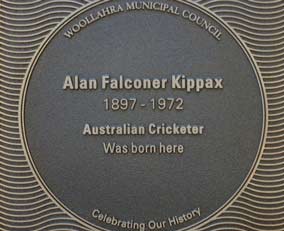
A plaque commemorating Alan Falconer Kippax was unveiled on 24 May 2019 in recognition of the 122nd anniversary of his birth on 25 May 1897.
The plaque is located outside the house which was occupied by the Kippax family in that year.
Alan Falconer Kippax (25 May 1897 - 5 September 1972)
Family background
Alan Kippax was the third son of Arthur Percival Howell (Percy) Kippax and his wife Sophia Estelle (Estelle) Kippax, née Craigie. His Australian-born parents had married at the Kippax family home in Park Road Moore Park on 10.4.1890i , where entries in the Sands Sydney Directory indicate that Percy and Estelle were still living with Percy’s widowed mother Eliza when their first two sons, Arthur Craigie Kippax and Roy Waugh Kippax, were born, in 1891 and 1892 respectively.ii By 1897, when Alan was born, the family was settled at 133 Windsor Street Paddington – their third son’s most likely birthplace, and his first home.
Entries in the Sands Directory show that by 1901 the family of APH Kippax had moved from Paddington to Woodstock Street, Waverley, and by 1902 to Penkivil Street Bondi – presumably the yet unnumbered 13 Penkivil Street, which was to be the Kippax home for the years of Alan’s childhood and youth.
According to information in the archives of the City Council,a Alan's father Percy worked as a clerk in the City's Treasurer’s Department, from 1882 to 1887, while Alan Kippax's official biographer further records Percy Kippax employment as a cashier.iii The Kippax connection with the City Council began far earlier, in 1863, when Percy's uncle William Kippax began a period of thirty-five years service as an alderman for the Cook ward of the City. Both Kippax Street in Surry Hillsb and Kippax Lake in Moore Parkc are named for Alderman William Kippax, Alan's great uncle - the latter landmark often mistaken as a tribute to Alan himself, given its proximity to the Sydney Cricket Ground.
Another member of the family whose name would take on household status in Sydney was Harry Gemmel Kippax, Fairfax journalist and editor, overseas correspondent in both war and peace time, and ultimately a renowned theatre and literary critic. Harry Kippax - known always as 'H.G.', was the son of Alan's brother, Arthur Craigie Kippax and his wife Marian Emily (Mayine) Kippax, nee Gibson, the daughter of W G Gibson, grazier from Hay, NSW.d
Both Alan Kippax's parents died in 1938, but not before witnessing the highlights of their youngest son's cricketing career.iv
Education and occupation
Alan Kippax attended Bondi and Cleveland Street Public Schools – an education which at first led to clerical work, until in 1926 he set up a retail business in Martin Place selling sports supplies. As director of the successful New South Wales Sports Store, Alan Kippax proved an able businessman.
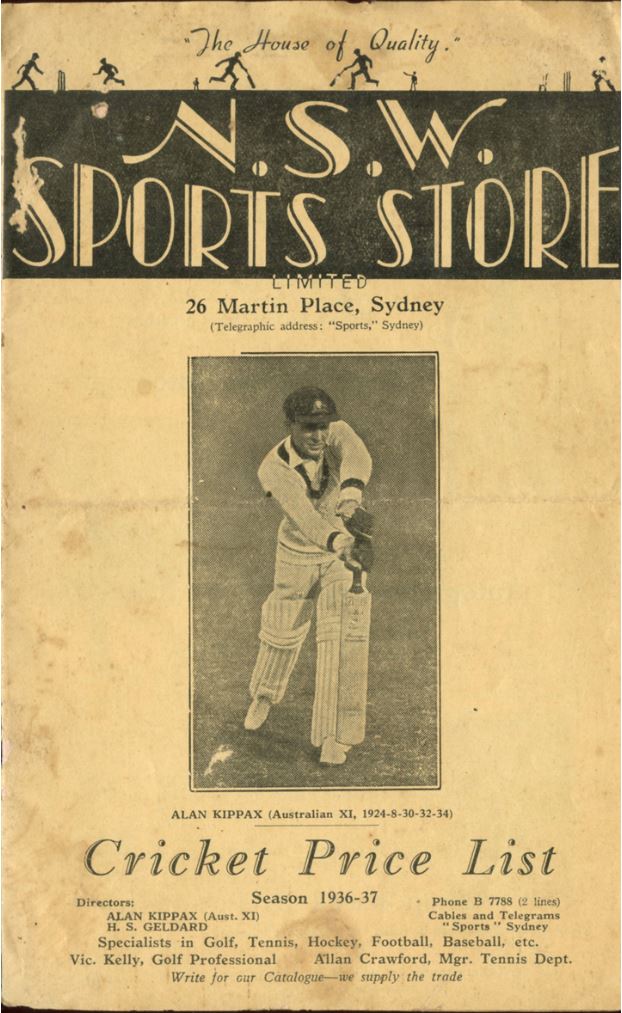
NSW Sports Store Catalogue 1936-37, featuring Alan Kippax on the cover.
While a boy at Bondi Public school, Kippax began to play team cricket, and grew up watching Victor Trumper, the renowned Paddington cricketer with whose batting style his own would later be compared. His potential as a cricketer was already evident before he had completed his schooling, illustrated in reminiscences in a report of his form as a 22-year old, by then a seasoned first-grader and representative of New South Wales :
In school-days he was the nightmare of bowlers, and piled up huge scores with a regularity that was exhilarating. (Smith’s Weekly 25.10. 1919 p. 8)
District cricketer
By his teenage years, cricket was beginning to occupy a central position in Kippax’s life and focus. He joined the Waverley District Cricket club aged 14, and by age 17 was elevated to consistent first-grade status. At 16, in an early first-grade appearance in a match against Glebe, Kippax had the bat knocked from his hand by the first ball he received – a victim of the fast-bowling of Alfred ‘Tibby’ Cotter, also known as ‘Terror’, whose ‘trademark was to shatter stumps’.v What followed was a measure of the player Kippax already was, and would remain. As recounted by cricketing writer Jack Pollard:
[Kippax] took the bat back from first slip and went on to make the first of 100 of the 7,114 runs he scored over 23 years with Waverley. (Pollard, Jack Australian cricket: the game and the players p. 572)
The resilience and grace shown in these circumstances by a 16-year old Kippax was a harbinger of Alan McGilvray’s description of a man, ‘who would never raise his voice or allow his emotions to run away with him.’vi
The figure which defines Kippax’s district play – 7,000 runs at an average of 53, for his grade club – is part of the overall batting strength which has become part of Kippax’s oft-cited legacy.
Even early in his career, Kippax would have been left in little doubt as to his club’s regard for him. Overlooked by test selectors for the touring side of 1926 – a decision which has been termed ‘one of the worst of all selection blunders’vii – Kippax’s local club swung into action and, ignoring the fact that the cricket season had already finished, staged a ‘testimonial match’ in Kippax’s honour at the Waverley oval.viii It was a tacit expression by team-mates of the incredulity openly expressed by the Sydney press, and a signal of local solidarity and tribute to a slighted club member.
Alan Kippax is generally felt to have come unfortunately late to state and test cricket, in a denial of the great potential he showed so early in his school and district cricketing days. This happened due to a number of coincidental factors in the timing of Kippax’s career. The first World War intervened and disrupted the routines of local sporting contests; post-war – as was observed by Donald Bradman (Kippax’s junior) - Kippax’s prime coincided with an unusual level of strength in the competition for places in the New South Wales team.
Kippax played his first state match in the 1918-1919 season, and by the 1922-1923 season was a regular part of the New South Wales side. He also toured New Zealand in a ‘second’ national touring side in 1921 and in 1928. He made his test debut as the English toured Australia in the 1924/5 season and was finally placed in a touring Australian team for the England tour of 1930.
Throughout this period of waiting for recognition from selectors, Kippax returned increasingly impressive scores in various engagements. His Sheffield Shield performance in the 1924/5 season earned him his place in the final test of the Ashes series, played in Sydney, where in a first innings partnership with Bill Ponsford, Kippax’s scoring is credited by Wisden as the factor that ‘turned the fortunes of the game’, propelling a previously flagging Australia to victory.ix
At Sheffield Shield level in the same season, Kippax held the highest score of the competition, including a 271 not-out result against the Victorian team, which similarly reversed the tide in favour of New South Wales. This in itself was expected to secure Kippax a place in the Australian touring team of 1926, until he was famously overlooked by the national selectors – an episode which some writers have argued was less oversight than the deliberate sacrifice of Kippax as a ‘sop’ to interstate rivalry. Nine of the 16 places on the touring team of 1926 were occupied by New South Welshmen. A tenth would have been difficult to justify.x
Perhaps his selection, in November 1926, as captain of the New South Wales team would have proved some consolation to Kippax for his omission from the tour.xi His continuing good form domestically would surely have proved another. The following summer, in a match against Queensland, Kippax scored 315 not out, in an innings which included 41 ‘fours’ from his bat. It was the highest single score of his career, and he ended the season with 926 runs at an average of 84.18.
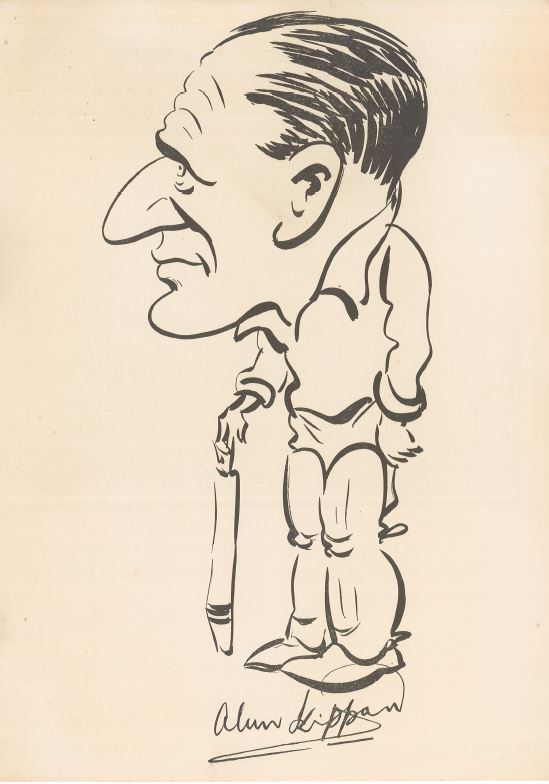
Caricature of Alan Kippax from Waverley District Cricket Club Testimonial Match Souvenir Booklet September 1939. Source: Private Collection.
View the Alan Kippax Testimonial Souvenir Booklet(PDF, 6MB)
Touring
While these scores at home must have been truly vindicating to the overlooked Kippax, it is doubtful, considering what has been recorded of the man’s character, that he would have derived any personal delight from the sound defeat abroad of the touring team from which he had been so contentiously excluded. Nonetheless, when Kippax was granted the opportunity to prove himself as a tourist, in 1930 and aged 33, he did not disappoint the selectors, showing a remarkable agility in adapting to the varieties of pitch and conditions which confounded fellow members of the team. In the second test he rescued an Australian first innings, when seven wickets had fallen for 77 runs, with his own 158 not out. He went on to score 102 in the second innings. In all he scored 1,451 across the test matches of this season at an average of 58.04.
While the 1930 tour was defined by the rising star of the young Don Bradman, to whom Kippax was second-highest scorer in all matches, many English cricketing experts ranked Kippax ahead of his teammate for his unfailing accuracy in reading and responding to the pitch.xii Back at home in the 1930/31 series against the West Indies, Kippax achieved the score which would be his personal highest in test cricket, attaining 146 runs in under four hours.
The Bodyline series
If Kippax’s entry into ‘big cricket’ was considered unluckily delayed, there is a general consensus that the final years of his career at this level were both curtailed and stymied by a range of misfortunes, prime among them the effect of the Bodyline tour. Kippax was sufficiently troubled by his firsthand observation of this strategy to co-author a book on the subject – motivated by his concern for its impact on the sport.xiii The book, while unashamedly polemical, was noted to have been ‘calmly expressed’ and ‘reasonable’xiv in its arguments, a restraint typifying Kippax’s personal style.
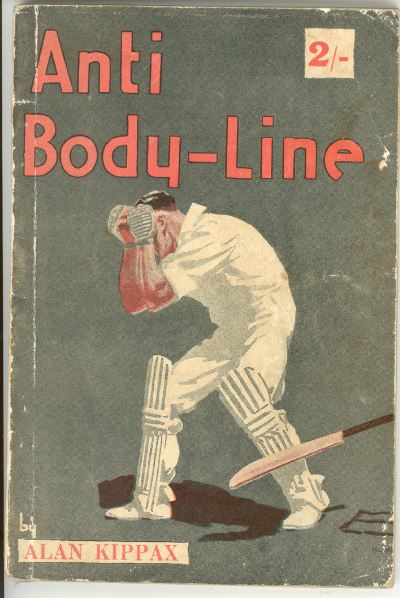
Book cover for 'Anti-bodyline' written by Alan Kippax, published in 1933 following the 1932-33 England tour of Australia.
When Kippax faced the bodyline bowlers of the 1932-1933 England tour of Australia, he did so having suffered two serious facial injuries from erratic deliveries in minor games in the lead up to the season. Team-mates noted the impact of this experience on Kippax, who afterwards lacked his characteristic confidence in deploying the ‘hook’ shot, hitherto the staple of his repertoire and one for which he had been famous. Bradman counted Kippax as its greatest exponent - and it has been observed that Kippax had continued ‘to play [the hook] like a teenager as he moved into his 30s’.xv
Kippax’s injuries (a broken nose and a blow to the temple leading to hospital admission) almost certainly gave him a new sense of vulnerability, just as his team faced an unprecedented assault from the touring British team in the summer of 1932/3. Bodyline had been conceived as a tactic specifically designed to curtail the high scoring Bradman, but was used indiscriminately against the Australian batsmen, and probably with special intent against Kippax – also a known high scorer, and often in partnership with Bradman.
Comments from both sides of the Bodyline controversy - Kippax’s frank dressing room admission re English fast bowler Harold Larwood, ‘He’s too bloody fast for me’, and Larwood’s later brutal pronouncement, ‘Kippax was scared stiff and he let you see it’,xvi together sum up a situation which saw Kippax successively demoted down the batting order, and finally omitted from the last of the series – finishing that test season giving radio summaries of the day’s play to an English audience, via the BBC.
Final tests and retirement
This wasn’t the finale to Kippax’s test career. He struggled, but eventually regained some of his former playing strength, and was selected for one final trip abroad, the 1934 tour of England, before which an agreement had been reached between Australian and British cricket authorities that Bodyline tactics would not be used.
Kippax’s last tour was marred for him personally by poor form and illness, both of which saw him out of play for much of the series, in which Australia regained the ashes. However, a glimpse of his earlier form was seen when, towards the last of the touring season, Kippax achieved his highest score in England – 250 runs against Sussex – and his first double-century in five years.
In all, Kippax’s test score from the 22 matches played amounted to 1,192 runs at 36, with two centuries.
Sensing his nearing retirement from first class cricket after the 1934 tour drew to a close, Kippax handed over the captaincy of the New South Wales team on his return from England. However, he continued to represent his state in Sheffield Shield matches until 1935. His final century at first class level was achieved in mid-December 1934, when he scored 139 runs in a match against South Australia. Overall, in first class matches, Kippax scored 12,750 runs at 58, with 43 centuries among them.
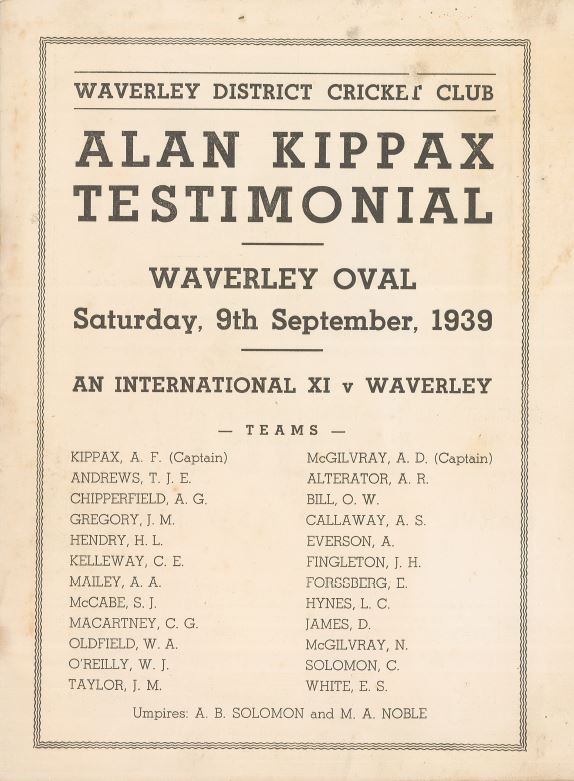
Extract from Souvenir Booklet, Alan Kippax Testimonial, Waverley Oval, 1939. Source: Private Collection
Undoubtedly Kippax’s most historically notable cricketing achievement occurred during Sheffield Shield play rather than in the international arena – but nevertheless setting a world record. This was his famous last-wicket partnership of 307 runs, achieved in a match against Victoria, played in Melbourne across the Christmas holiday. The match began on 22.12.1928 and during the third day of play, with New South Wales chasing a score of 376 from Victoria’s first innings, the situation for the visiting team fell to a seemingly desperate state with nine men out for 113 runs. Kippax, the captain, was still at the crease, at 20 runs not out.
Together with his 11th man, Halford Hooker, Kippax staged a ‘last wicket stand’ which had the crowd at the MCG swelling ultimately to 15,000, as news spread beyond the ground. Play resumed the next day and when the seeming impasse was finally breached, 307 runs had been added to the New South Wales total, and Kippax’s personal score for the innings stood at 260 not out. Hooker, who had himself achieved a remarkable feat in withstanding the attack, and reliably setting up play for Kippax, was out for 62.
They batted for a whole day, with Kippax scoring at a rate of 48 runs per hour and carried on into the next day…Their last wicket partnership, a world record, had seen a glorious display of Kippax stroke-making for more than five hours as he lifted his score by 238 runs … (Pollard, Jack Australian cricket: the game and the players p. 572)
The Kippax incident
One incident in Kippax’s career caused great debate in cricketing circles, and in the pages of the Sydney and regional press. Kippax was batting in the 2nd English test at Sydney in December 1928 when the bails were knocked from the wicket by the ball. How, was never satisfactorily resolved, with some observers claiming the ball was deflected from Kippax’s own extended foot, others from the wicketkeeper’s pads. The umpire at the bowler’s end refused an initial appeal from the bowler. However, the subsequent appeal of an English fieldsman to the umpire at square leg was upheld – the square leg umpire belatedly recognising his error in making such a call from his position.
Kippax, in the face of the second umpire’s call, and the taunts of English fieldsmen, walked from the pitch without argument – and then repeatedly refused to be drawn by the press on his decision to do so. Likewise the [Australian] Board of Control declared the matter ‘dead’ – but prudently requested a written umpires’ report, and remarked that it would be tendered to the selection for umpires.xvii Separately, the incident grew into a debate in the pages of the newspapers and among the public – but Wisden notes that while there was some ‘feeling’ about this event, ‘happily, however, the good relations which existed throughout the tour were quickly restored.’xviii
Alan Kippax captained the New South Wales cricket team for a total of eight years, from November 1926 until December 1934, leading his team mates through 45 matches, winning 19, drawing 17 and losing nine. It was said that during this time Kippax:
…welded with wit, kindness and some practical joking a raw team into a formidable unit, nurturing such youngsters as Archie Jackson, Stan McCabe and (Sir) Donald Bradman; through him the Trumper style passed to Jackson. (Andrews, B G. Australian Dictionary of Biography pp. 606-607)
Kippax was also in demand to provide commentary on Test matches. ;In the 1930s, he was part of communications history-in-the-making as his commentaries went out via a radio-telephone service providing direct radio broadcast of matches from Australia to England.xix
Kippax was appointed a trustee of the Sydney Cricket ground in 1938.xx
Style and character
Rarely is comment passed on Kippax’s style as a batsman without it being paired with a reference to his style as a man, or with comment on his dress, demeanour and nature – perhaps reflecting the English critic Neville Caradus’s observation that ‘A true batsman should in most of his strokes tell the truth about himself.’ Terms such as elegance, great personal charm, and kindliness recur in writing about Alan Kippax – historical and contemporary – and there appear to be no dissenting voices.
Kippax’s official biographer writes that his subject was an
impeccably correct and elegant batsman … [with] and upright easy stance at the wicket; like his schoolboy idol Victor Trumper, he rolled his sleeves between his wrist and elbow and excelled with the late cut. (Andrews, B G. Australian Dictionary of Biography pp. 606-607)
Player and commentator Alan McGilvray remembered him as ‘meticulous in his dress and his life … an admirable, engaging man;’xxi Neville Caradus wrote that Kippax ‘ pleased the eye of the connoisseur all the time’, when analysing his batting at the Lord’s Test in 1930xxii while cricket historian David Frith, offered a glimpse of the private Kippax:
To visit him [Kippax] in his Bellevue Hill home is to be transported into a calm 1930s world of silk smoking jacket, cigarette holder and art deco trimmings. (Frith, David Bodyline autopsy pp. 423-424)
Perhaps the highest praise reserved for Kippax’s batting style came from the junior player who rapidly eclipsed his mentor’s scores. Writing of Kippax’s performance in a 1926/7 match against Queensland at the SCG, when Kippax’s attained the highest score of his career (315 not out, amassed in 388 minutes) Don Bradman noted
…although they say that Victor Trumper was even more beautiful to watch, it is hard to conceive more graceful batting than our skipper produced on that occasion. (Bradman, Don Farewell to cricket Syd., Pavilion, 1988)
It has been said that to assess Kippax’s worth as a batsman by runs is too simplistic – his batting instead should be measured ‘in carats’.xxiii
Alan Falconer Kippax died of heart disease, at Bellevue Hill, on 5.9.1972. He was survived by both his brothers, Arthur and Roy, and also by his wife, Mabel.
Born Mabel Charlotte Catts, Alan Falconer’s wife was described as the youngest daughter of Mrs A H Catts, of Chatswood in accounts of her marriage with Alan Kippax on 20.4.1928 at St Stephen’s Church, Sydney. The groom was attended by three well-known cricketers, Gordon Morgan, Vic Richardson and Jack Gregory. Mabel outlived her late husband by twelve years, and died 25.10.1984.
Honours and awards
Alan Kippax was honoured during his life by a number of formal tributes.
In 1943 he was elected as a Life Member of the New South Wales Cricket Association.
In 1949 a testimonial match was held to jointly honour William (Bill) Oldfield and Alan Kippax, who had been team mates. The citation for Kippax attached to this occasion read :
One of the most graceful batsmen to have represented Australia; considered of his day to be the nearest to Trumper in beauty of style and stroke execution. Fine fieldsman with strong return. (The Sun Herald 20.2.1949 p. 22)
Don Bradman, aged 40, played his farewell innings at the SCG in this match, amassing 53 runs in 65 minutes.xxiv
On 1.4.2016, A F Kippax was inducted into the Cricket NSW Hall of Fame, along with Belinda Haggert and Andrew Bevan, the latter who had finally broken, in March 2003, the First Class career record set by Kippax on retirement of 8,005 runs in 87 matches.xxv
As a sportsman
Kippax was a general lover of sport – as a young man playing base-ball in the cricketing ‘off-season’, cricket in the cricket season, and opening his city-based sports-store as a personally fulfilling means of providing a livelihood around his amateur sporting status.
In his retirement, Alan Kippax continued to enjoy a sporting life: golf at The Lakes Golf course, and lawn bowls at the Double Bay Bowling Club. This deep-seated enthusiasm, coupled with well-recognised sportsmanlike conduct in all avenues of his life, made him a deserving role model for aspirant cricketers, and a natural ambassador for representative sport. His eight-year captaincy of the New South Wales cricket team showed him to have all the personal requirements for effective leadership.
A living memory of Alan Kippax's generosity of spirit, consistent with what is written of him, is shared by a personal recipient - Phil O'Sullivan. Phil's love of cricket began as a four-year old, when his enthusiastic father took out membership for him of Kippax's Waverley Cricket Club. He recalls from his school days, standing at the fence-line of Waverley Oval with two fellow Waverley College lads, to watch Alan Kippax in practice. It was the mid-1930s, the era when Kippax was transitioning back to club cricket, which he had never fully abandoned, even in touring days. As the other first-grade players drifted back to the pavilion at the close of practice, Alan Kippax would summon his young audience and hold an impromptu coaching session, dispensing tips and wisdom beyond value to the three schoolboys. As Phil recalls, Kippax was both gentle and gentlemanly, standing out from the ordinary in both manner and character. While an injury prevented Phil O'Sullivan from reaching his potential as an athlete, as a coach and President of the Waverley Cricket Club, he has passed on what he had learnt from a generous Kippax to other generations of young cricketers.
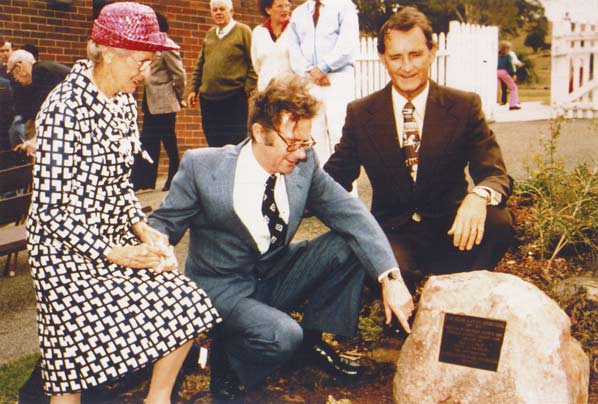
Mabel Kippax, Ernie Page (Mayor of Waverley Council) and Phil O'Sullivan OAM with the Alan Kippax Memorial Plaque, unveiled at Waverley Oval in 1980. Source: Private Collection
Relationship to Woollahra
In 1928, following his marriage to Mabel Catts, Kippax and his new wife forged a connection with the Woollahra area, when they settled in Bellevue Hill. Over the next 43 years the couple lived at several different localities within the suburb.
With the addition in 1968 of the northern portion of the suburb (and former municipality) of Paddington into the municipality of Woollahra, Kippax’s likely birthplace and certainly his first home, in Windsor Street Paddington, became part of Woollahra, and was chosen by Woollahra Council as the site of a plaque to Alan Falconer Kippax.
Contribution to cricket
Test cricketer Alan Falconer Kippax’s outstanding style as a batsman, which attracted superlatives from both players and critics, was a vital aspect of his contribution to the main spectator sport of the Australian summer. While this refinement translated into a solid, rather than a record-breaking batting average in his test career, Kippax proved himself capable of achieving exceptional scores in individual matches, at times setting world-standard records, while the figures derived from his domestic cricketing career demonstrate sustained excellence.
Forty-seven years after his death, and eighty-four years after his retirement from ‘Big cricket’, when a plaque was unveiled in Windsor Street Paddington to honour him, Alan Kippax remained in the public memory as a well-known and well-regarded cricketer. Kippax set a high standard for others to follow, not only in the batting averages he attained, but in the respect he commanded through his fair and principled approach to representative sport.
Bradman saw his mentor’s legacy to cricket in the graceful but effective batting style he inherited from Trumper, preserved in his own play, and then passed on to other younger players, noting :
His [Kippax’s] Trumperian style must have influenced for good vast numbers of young boys. Unquestionably the line of Trumper and Kippax has much to do with the grace and elegance which is more frequently associated with players from NSW than from other states. (Bradman, Don Farewell to cricket p. 79)
Published works
- Andrews, B G ‘Kippax, Alan Falconer 1897-1972’ Australian Dictionary of Biography vol. 9 Melb. Univ. Pr., 1983.
- Bradman, Don Farewell to cricket Adel, Pavilion, 1988.
- Derriman, Philip The Grand Old ground: a history of the Sydney Cricket Ground Syd., Cassell, 1981.
- Frith, David Bodyline autopsy, Canb., ABC Books, 2002.
- Pollard, Jack Australian cricket : the game and the players Syd., Hodder & Stoughton, 1982
- Sands Sydney Directory. Syd., John Sands Ltd., 1858 -1932.
Unpublished sources or archive collections
- Trove – Newspaper collections, National Library of Australia
Footnotes
i Sydney Morning Herald 3.5.1890 p. 1 (Address now Moore Park Road)
ii NSW BDM Refs : 833/1891; 3155/1892.
iii Andrews, B G ‘Kippax, Alan Falconer 1897-1972’ Australian Dictionary of Biography vol. 9 Melb. Univ. Pr., 1983.
ivSydney Morning Herald 13.9.1938 p. 12; Sydney Morning Herald 12.12.1938 p. 1
v Lane, Daniel ‘How the bowler they called ‘Terror’ became a casualty of war’s horror’ Sydney Morning Herald 25.4.2010 p. - https://www.smh.com.au/sport/cricket/how-the-bowler-they-called-terror-became-a-casualty-of-wars-horror-20100424-tkfa.html
vi McGilvray, Alan ad Tasker, Noman The Game is not the same Canb., ABC Books 1985
vii Pollard, Jack Australian cricket: the game and the players p. 572
viiiThe Arrow 23.4.1926 p. 12
ix ‘Australia v England 1924/25’ Wisden 1931.
x Pollard, Jack op. cit.p. 572
xiThe Canberra Times25.11.1926 p. 5
xii Pollard, Jack op. cit. p. 573
xiiiAnti-bodyline/Kippax, Alan and Barbour, Eric P Syd., Syd & Melb Publishing Co., 1933.
xiv Frith, David Bodyline autopsy Canb., ABC Books, 2002 p.379
xv Pollard, Jack op. cit.p. 572
xvi Frith Op cit pp 119; 435
xviiThe Armidale chronicle 22.12.1928 p. 2
xviii Wisden archive Second Test Australia v England 1928-29 http://www.espncricinfo.com/wisdenalmanack/content/story/151730.html
xix Bradman, Don op.cit p.
xxNSW Government Gazette 7.1.1938 p. 3
xxi McGilvray & Tasker op cit p.43
xxii Cashman Richard The Oxford Companion to Australian cricket Ox. Univ. Pr.
xxiii Pollard, Jack op cit p. 573
xxiv Derriman, Philip The Grand old Ground Syd., Cassell, 1981 p. 84
xxv Cricket NSW News 31.3.2016
aEmployees of the City of Sydney, 1842-c1900
b'The Streets of your town', City of Sydney
cCentennial Parklands, Moore Park, Kippax Lake
dThe Riverine Grazier 5.12.1919 p 2; The Riverine Grazier 26.10.1920 p. 2
New plaques are added based on nominations from the community, which are then assessed against selection criteria and researched by a Local History Librarian.
Find out more and nominate a person or event for a plaque.